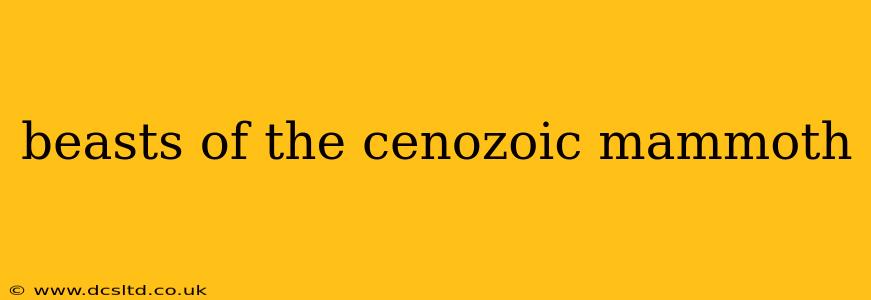The Cenozoic Era, spanning from 66 million years ago to the present, witnessed an incredible array of megafauna. Among these giants, the mammoths stand out, captivating our imagination with their impressive size and intriguing evolutionary journey. This post delves into the fascinating world of Cenozoic mammoths, exploring their diverse species, adaptations, and ultimate demise.
What is a Mammoth?
Mammoths were proboscideans, belonging to the same order as modern elephants. They were characterized by their long, curved tusks, shaggy coats (in many species), and large size. While often depicted as solely woolly mammoths, the term "mammoth" encompasses a diverse group of extinct elephant relatives that inhabited various regions across the globe.
What were the different types of mammoths?
Several mammoth species roamed the Earth during the Cenozoic. Some of the most well-known include:
-
Woolly Mammoth ( Mammuthus primigenius): This iconic species is famous for its thick, shaggy fur, ideal for surviving the harsh, icy conditions of the Pleistocene epoch. Its remains have been found extensively across the Northern Hemisphere.
-
Columbian Mammoth ( Mammuthus columbi): This larger species inhabited North America, boasting impressive tusks and a less hairy coat than its woolly cousin.
-
Imperial Mammoth ( Mammuthus imperator): One of the largest mammoths, it also roamed North America, characterized by its massive size and long, straight tusks.
-
Steppe Mammoth (Mammuthus trogontherii): A transitional species, possessing characteristics of both earlier and later mammoth species.
These are just a few examples; the mammoth family tree is quite extensive, showing significant diversification across various continents and climates.
When did mammoths live?
Mammoths first evolved in Africa during the Pliocene epoch (around 5 million years ago) and subsequently migrated to other continents, including Eurasia and North America. Different mammoth species existed across various periods within the Cenozoic, with some persisting until relatively recently. The last woolly mammoths died out around 4,000 years ago on Wrangel Island, a remote island in the Arctic Ocean.
How did mammoths become extinct?
The extinction of mammoths is a complex issue, with no single cause universally accepted. However, several contributing factors are widely considered:
-
Climate Change: The changing climate during the Pleistocene-Holocene transition significantly altered their habitats, impacting food availability.
-
Human Hunting: Evidence suggests that humans hunted mammoths, potentially contributing to their decline, especially in conjunction with other pressures.
-
Disease: Outbreaks of disease could have further weakened already stressed populations.
The interplay of these factors, rather than a single cause, likely led to the extinction of these magnificent creatures.
What is the difference between a mammoth and a mastodon?
While both mammoths and mastodons were proboscideans, they were distinct groups. Mastodons (genus Mammut) generally possessed shorter, straighter tusks and had a lower, more sloping skull. Their teeth were also different, adapted to a more browsing diet compared to the grazing habits of many mammoth species.
Where can I find mammoth fossils?
Mammoth fossils have been found in various locations worldwide, particularly in regions with permafrost or previously glaciated areas. Museums across the globe often showcase impressive mammoth specimens, offering fascinating insights into these prehistoric giants.
This exploration of Cenozoic mammoths reveals their fascinating diversity and the compelling story of their evolution and extinction. Further research continually unravels new details about these remarkable creatures, deepening our understanding of the past and the forces that shaped the world we inhabit today.
